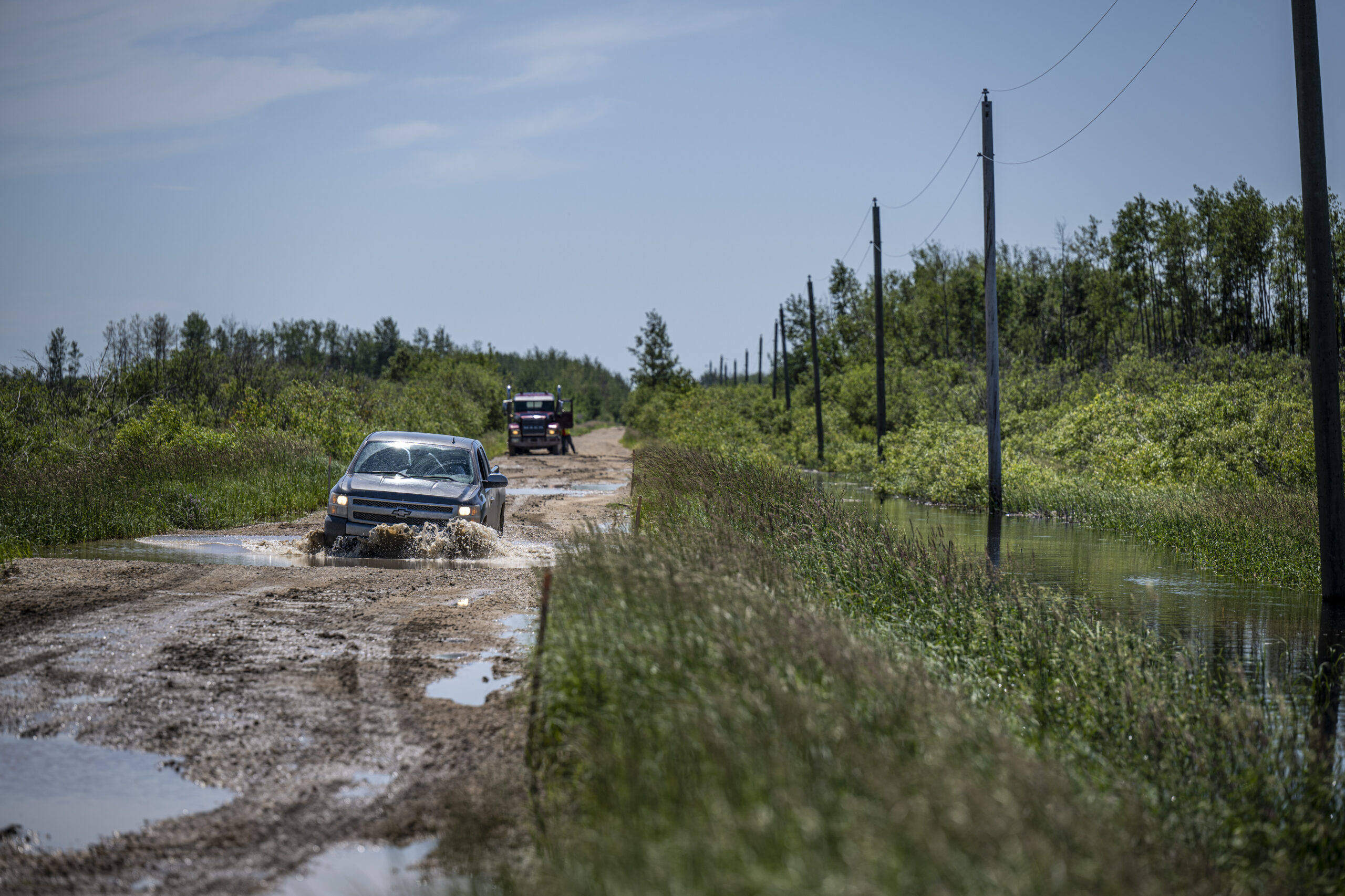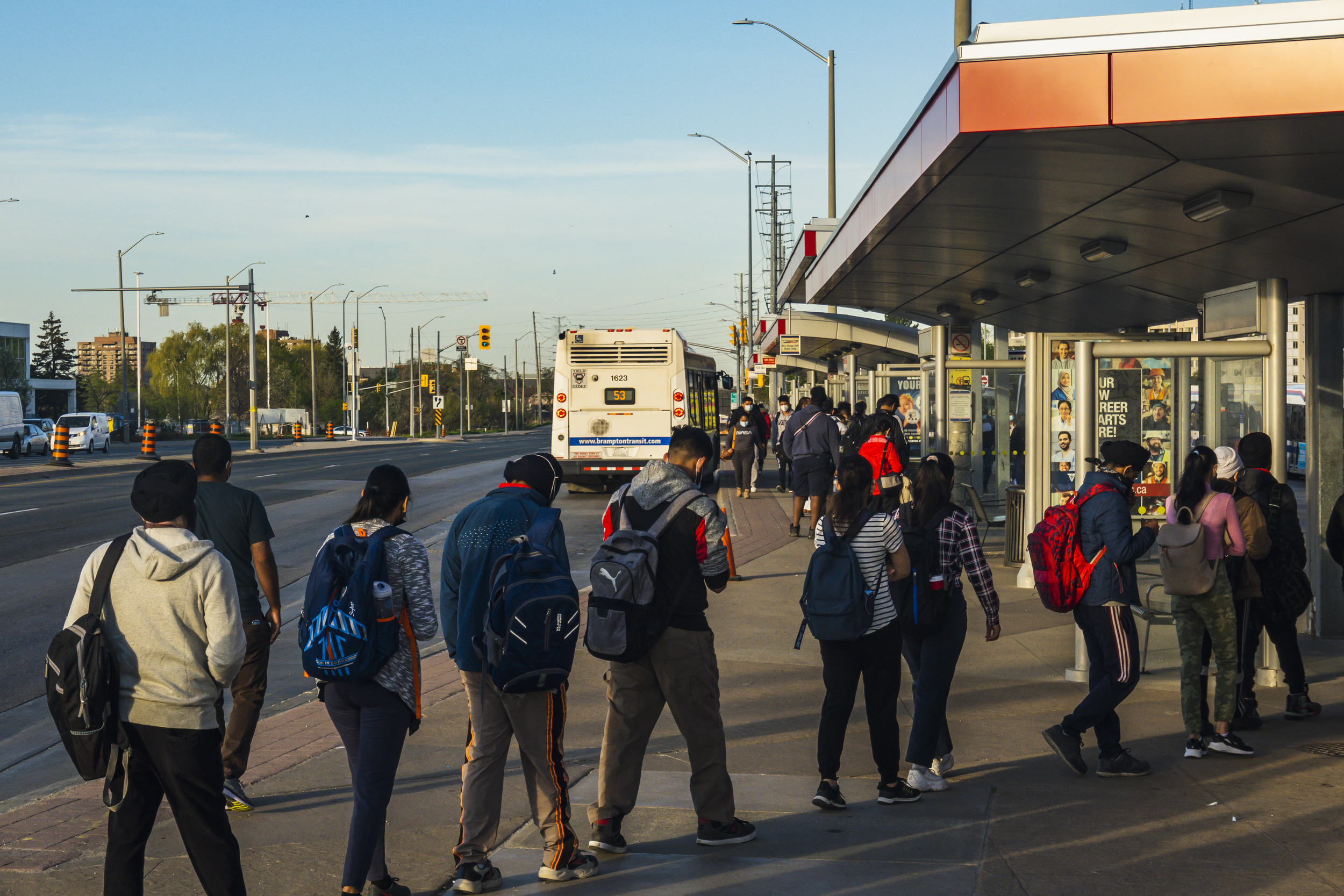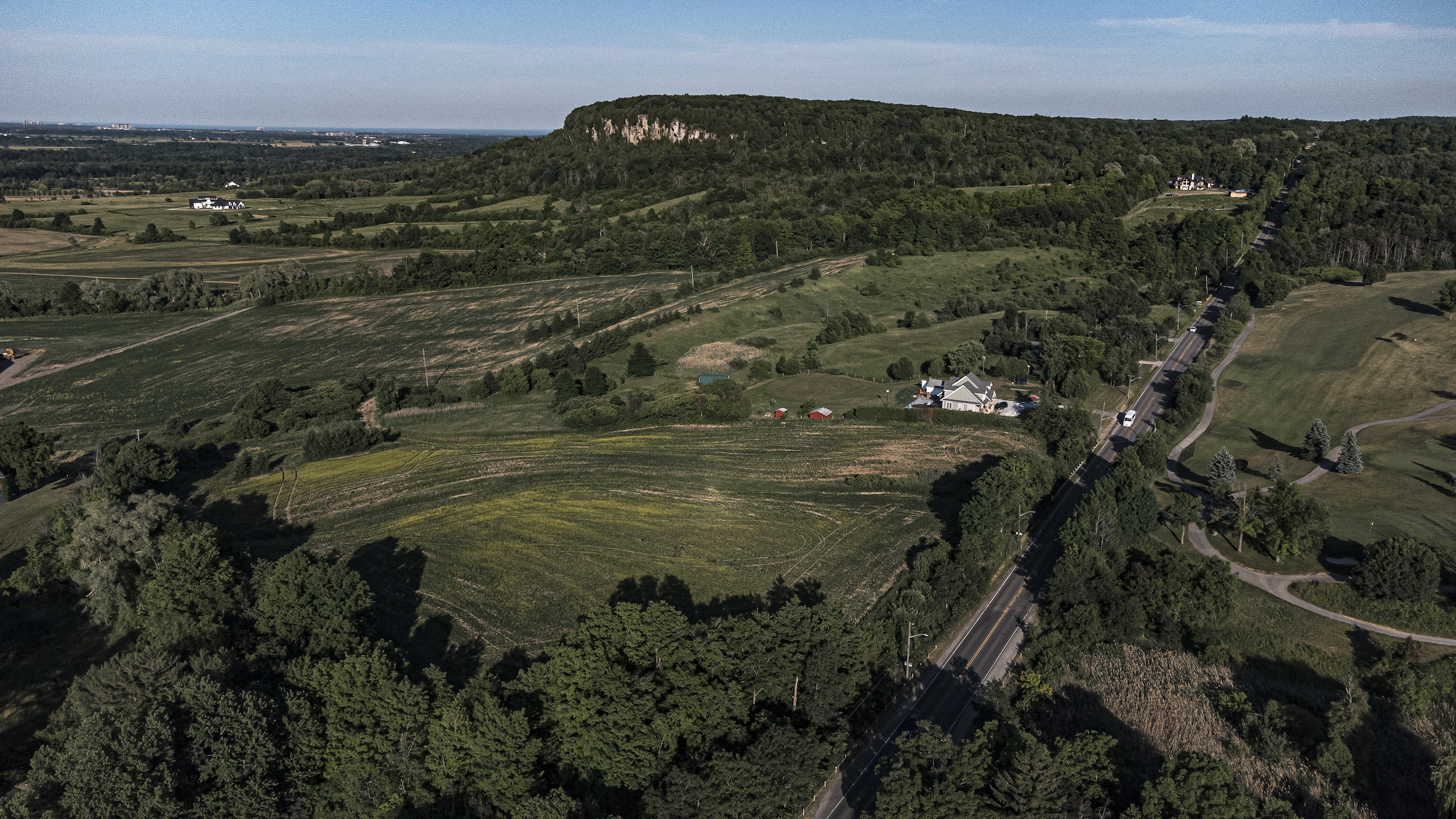
The Narwhal picks up National Magazine Award nomination for Amber Bracken’s oilsands photojournalism
Bracken was recognized for intimate portraits of residents of Fort Chipewyan, Alta., who told her...
From flying hundreds of metres over giant mines to stumbling onto bikes to visit garbage piles-turned-bird sanctuaries, our team at The Narwhal has reported from across Canada this year. Some stories were bleak — lingering contamination from spilled gas in Alberta to gutted environmental protections in Ontario. Others, however, were more hopeful, looking at Indigenous youth connecting with their culture and environment or a displaced First Nation finally returning home.
All these stories had one thing in common: a beautiful display of how we’re all intertwined with the natural world — with stunning photos, to say the least.
Here are some behind-the-scenes looks into our favourite stories of the year!
Seeing an open-pit mine site from the air was a wild ride. We were invited to join the Confederated Tribes of the Colville Reservation, American environmentalists and American journalists to get a bird’s-eye view of the Copper Mountain mine and its tailings dams in southern B.C. this fall.
I crammed in the very back of a small six-seater Cessna and our barely caffeinated crew took off just after sunrise. It was an amazing perspective to see how interconnected the ecosystems surrounding the mine are, how inconsequential an international border looks from the sky and how close people are living to the mine’s tailings dams.


As I was digesting everything we had seen, the reporter beside me was trying to keep what she had digested down. It was a bumpy, hot ride with little airflow and pretty tight seating.
At the smallest indication of possible air sickness, the pilot was quick to direct her to a bag and warned us, “If one of you gets sick, I’ll get sick too.” I spent the rest of our flight back trying not to imagine the pie-eating competition scene from the ’80s film Stand By Me.

I’m pleased to say we landed safely without any incidents, and a greater appreciation for on the ground reporting.
– Francesca Fionda, mining reporter
At the root of many of the stories we cover are Indigenous Peoples being displaced — whether it be for development of cities, extraction of resources or even national parks.
But at the heart of these stories is people retaining their connection, or returning home.
I love when our images really show all the beauty and deepness of that connection — and the photos of the Mamalilikulla returning home just blew me away.


The Mamalilikulla First Nation was displaced from their territory on the Pacific coast in the 20th century. But last year, they unilaterally declared an Indigenous Protected and Conserved Area at Gwaxdlala/Nalaxdlala (Lull Bay/Hoeya Sound). They invited me and photographer Taylor Roades to attend their community dedication event in May, and I felt so privileged to attend this significant day. Many of these people had never been to this part of their territory. And it was the first time in 100 years anyone had sung or danced there.

It was freezing — a wet, wet cold. Elected Chief Councillor John Powell picked up ponchos for everyone. There were strong winds and rain came down sideways. Everyone stood in muddy puddles, the branches swayed overhead. And everyone smiled and laughed. They shared seafood chowder and huddled under umbrellas. Powell, who is also a fashion designer, wore his crocodile leather dress shoes with his regalia. I was not the only one who was impressed by how comfortable he seemed in the cold.
At the heart of these stories is people coming home, and all of Taylor’s photos capture that deep connection beautifully.
– Steph Kwetásel’wet Wood, B.C. reporter
The day I went to Toronto’s Tommy Thompson Park with photographer Carlos Osorio, I woke up an hour before dawn and blearily stumbled onto my bike. The only thing that got me, a notorious sleepyhead, out of bed was the knowledge that we were about to experience a day of pure magic.
Tommy Thompson is already a funny place that’s full of contradictions, a park built on top of literal garbage. Parts of it are a natural haven, parts of it feel like a scene from The Lorax. It’s also my favourite place to be on spring mornings, when bird migration season transforms the park into a wonderland of avian action. Carlos and I had both recently gotten into birding, and we just knew we were in for a magnificent day.


We met up in the parking lot as the first rays of dawn started hitting the trees. With binoculars in tow, we set off and biked around the park’s trails for two hours, stopping every minute or so to point and go “There! Oh my gosh! What’s that?” and consult the Merlin app to identify the species. All for journalistic purposes, of course. We had to wear masks to stop the thick clouds of mayflies from taking up residence in our mouths, but that didn’t even matter! By the time we met up with Andrea Chreston of the Toronto and Region Conservation Authority for a tour of the Tommy Thompson Bird Research Station, we were positively glowing. Or was that just my sunburn?
Hanging out with the folks at the station was somehow even more incredible. We spent hours tagging along as they checked nets, banded the birds and released them, totally mesmerized. We just kept whispering “This is soooooo cool” back and forth.

Unfortunately, we couldn’t get up close to the cormorants, which might unleash some very acidic vomit on you if you encroach on their space. But I think that was for the best. Watching them build nests from a safe distance, I couldn’t help but fall in love with them, even though they make oinking noises and generally lack the charisma of the songbirds.
All in all, it was a reminder of how much joy and hope the natural world can give us, even in the city. Carlos captured that golden wonder perfectly. Plus, we each added a few special birds to our life lists. Shoutout to scarlet tanagers! I’ll hold this day in my heart all winter long.
– Emma McIntosh, Ontario reporter
The stretch of freeway between Calgary and Airdrie, just to the north, is busy. There is a constant stream of speeding cars and trucks, racing along what is sometimes called the Golden Corridor between the southern Alberta energy capital and the political capital of Edmonton. It’s easy to miss the Horseman Motel off to the side of that thoroughfare.
That’s where I met Zubeda Jessa, sitting behind the counter of the Horseman liquor store beside the motel.
She and her family have been fighting for compensation since discovering contamination under their land more than 30 years ago. With no end in sight, Zubeda dutifully sits in her chair behind the counter of the store, serving the customers who came in as we spoke and who all seemed to know her name.


The store and the motel felt stuck in time, much like the Jessa family. They are all sitting there on the side of the highway, waiting for something to change so they can move on. But the legal battle with Suncor drags on.
It’s the kind of story that you can’t really tell properly without visiting the place. To see the dust on some of the wine bottles. To see the little bits of the motel that are fraying. To see the monthly room rates that are now the lifeblood of the business posted on the window. To feel the stagnation.
And to see Zubeda, sitting in her chair so many years after they first discovered the impacts of leaking oil tanks under their land — a Petro-Canada station visible behind her — and to see in her eyes that she is not going to give up the fight.
– Drew Anderson, Prairies reporter
On the drive up to the Nisg̱a’a village of Ging̱olx, photographer Marty Clemens asked me what the story we were going to report on was about. On most field assignments I have a clear answer. This time, I had to say I had no idea. All I really knew was that Nisg̱a’a scholar Andrea Reid was running a science camp for kids and she’d welcomed us to join. We’d talked on the phone a couple of times but never met in person.


The next morning, at the village longhouse, Reid directed two kids to hop in my car as we convoyed out to a nearby oolichan fish camp. Ryker and Rocko shyly climbed in the backseat and barely said a word on the drive. At the fish camp, we all learned about catching and processing the little oily fish and its role in Nisg̱a’a history and culture. The kids slowly started to warm up to us being there.

The rest of the trip was an immersive and joyful experience. I gave shoulder-rides, skipped rocks and fixed slingshots. We played games and we ate together. We talked about everything and nothing.
By the end of our three days in Ging̱olx, I still didn’t know what I’d write — but it didn’t matter. The story was secondary to the trust that had been given to us and all the shared moments.
– Matt Simmons, northwest B.C. reporter
We were standing in Derek Sutherland’s kitchen when the floodgates opened. A sudden summer storm had descended on Peguis First Nation in Manitoba, rattling open Sutherland’s doors and spraying the room with mist. Sutherland led photographer Aaron Vincent Elkaim and I to his basement, where he used a long-handled squeegee to sweep away the floodwater coating the floor.
It was the 20th time Sutherland had to bail his basement out that year. It wouldn’t be the last.


It can be hard to capture grief in words. Over the course of our day in Peguis, a few weeks after the worst flood in the community’s history, Aaron and I sat with countless families battling the despair of indefinite displacement and government indifference. The heartbreak was palpable not just in what we heard that day, but in what we saw, too: the mould-streaked walls in homes that won’t be safe to live in again, the gravel roads, bridges and culverts washed out by the flood, the piles of damage claims at the emergency centre.
Our drive back to Winnipeg was quiet. We let the radio fill the silence as we sat with our anger and despair. For decades, successive provincial and federal governments have left Peguis to fend for themselves, offering emergency aid without permanent protection. Every few years the waters rise again, and the challenges start anew.

But the photos and stories from that day capture more than just grief; they capture the community’s undeniable strength, too. The tireless work of emergency coordinators, the relentless persistence of community members demanding action from leaders of all political stripes and the kindness of volunteers who bail out and clean their neighbours homes have all kept the community afloat.
It’s the fight carried on by people like Sutherland — who would sooner move the house to a new foundation on higher ground than give up on his family’s home — that remind us of the life-giving powers of community, and of hope.
– Julia-Simone Rutgers, Manitoba reporter
During the pandemic, the transit landscape in Mississauga, Ont., began to change in a big way. From my balcony, I watched as the city — known widely across the province as a place of massive car-dependent urban sprawl with barely any land left to develop — began digging one of the main roadways to build its first light-rail transit.
So often when we think about transit we think about concrete, wheels and railways. But we don’t immediately think about people. This new transit project was being marketed as a solution for workers across Mississauga and surrounding cities to move around more easily. So we decided to go talk to them.


From 9 a.m. to 6 p.m., photographer Carlos Osorio and I journeyed up and down the road I’ve lived on for more than a decade. We stopped at every bus stop and every major transit hub. Carlos was able to see what I couldn’t as a daily user: that the way transit and human lives interact is beautiful. Studying and learning the way people gather, talk to each other and organize themselves around transit revealed more about the merits and challenges of the project than the documents I had read. We met bus drivers, students, nurses, new immigrants, uncles, gas station attendants and senior citizens who had ridden the bus for decades.

So often, we had literal seconds to take a photo of them before they jumped on a bus about to drive off. This was one of the simplest and most novel stories I wrote in 2022: what do people in my Canadian hometown think about a new transit project? But Carlos was able to capture the essence of what transit is really about: the people who ride it every single day.
– Fatima Syed, Ontario reporter
The best photojournalists (and art directors and illustrators) I’ve worked with are those that can somehow understand how to turn my terrible, poorly conveyed ideas into the perfect visual complement to a story. And the photographer that has most made The Narwhal’s Ontario bureau’s dreams come true this year is Christopher Katsarov Luna. We’ve sent him off to various parts of the Golden Horseshoe with vague instructions about “what sprawl looks like,” and he’s come back with all sorts of gems that show us, well, what sprawl looks like.


From images of a bleached Stoney Creek farm with a For Sale sign to the rolling hills of Milton with just a hint of urban encroachment in the background, Chris’s images came in extremely handy in the fall, when we were furiously reporting on the Doug Ford government’s massive changes to development policy, made in the name of solving the housing crisis. Along with on-the-ground shots, Chris has also sent in gorgeous, soaring drone photos that help show the scope of what’s at stake, like the vibrantly green Garner Marsh in Hamilton, which we used in a story about why protecting wetlands is also protecting every home in Ontario from floods.
If I had to choose one of Chris’ images to highlight from 2022, it would be this one.

It’s an aerial shot of suburban housing development with an imaginary but definite line separating it from a bushy forest. The trees are doing their tree things — cleaning the air, housing animals and all the other invisible, invaluable tasks we take for granted — unaware how threatened they are by conversations happening in the concrete jungle not so far away. The tensions over just how Ontario should accommodate an exploding population are at a height, and with this photo, Chris simply, beautifully illustrates our choices.
– Denise Balkissoon, Ontario bureau chief
